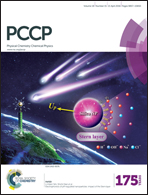Electrochemical synthesis of poly(3-aminophenylboronic acid) in ethylene glycol without exogenous protons†
Abstract
A non-aqueous solution of tetra-n-butylammonium fluoride (TBAF) in ethylene glycol has been tried for the first time as a supporting electrolyte for the electropolymerization of 3-aminophenylboronic acid (APBA). Unlike the traditional acidic aqueous solution, the present medium needs no exogenous protons; moreover, the presence of CF3COOH is found to be unfavorable for the polymerization. The protons are in situ generated by the reaction between the boronic acid group on APBA and 1,2-dihydroxyl on ethylene glycol. So, ethylene glycol serves as not only the solvent but also the proton source. As a part of the supporting electrolyte, F− is found to be involved in the electrochemical synthesis of poly(3-aminophenylboronic acid) (PAPBA), but it is not indispensable. Studies on the electropolymerization process indicate that the size of the ions in the electrolyte affects the rate of the doping/dedoping process. The smaller the cation, the easier the doping/dedoping process, and the better the stability of the grown film. As demonstrated by Fourier transform infrared spectra, UV-vis spectra, and scanning electron microscopy, the obtained PAPBA is a cross-linked nanoporous polymer membrane that has a good adherence to the glassy carbon electrode.


 Please wait while we load your content...
Please wait while we load your content...